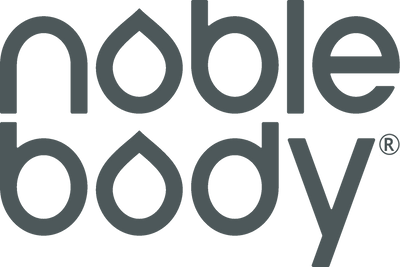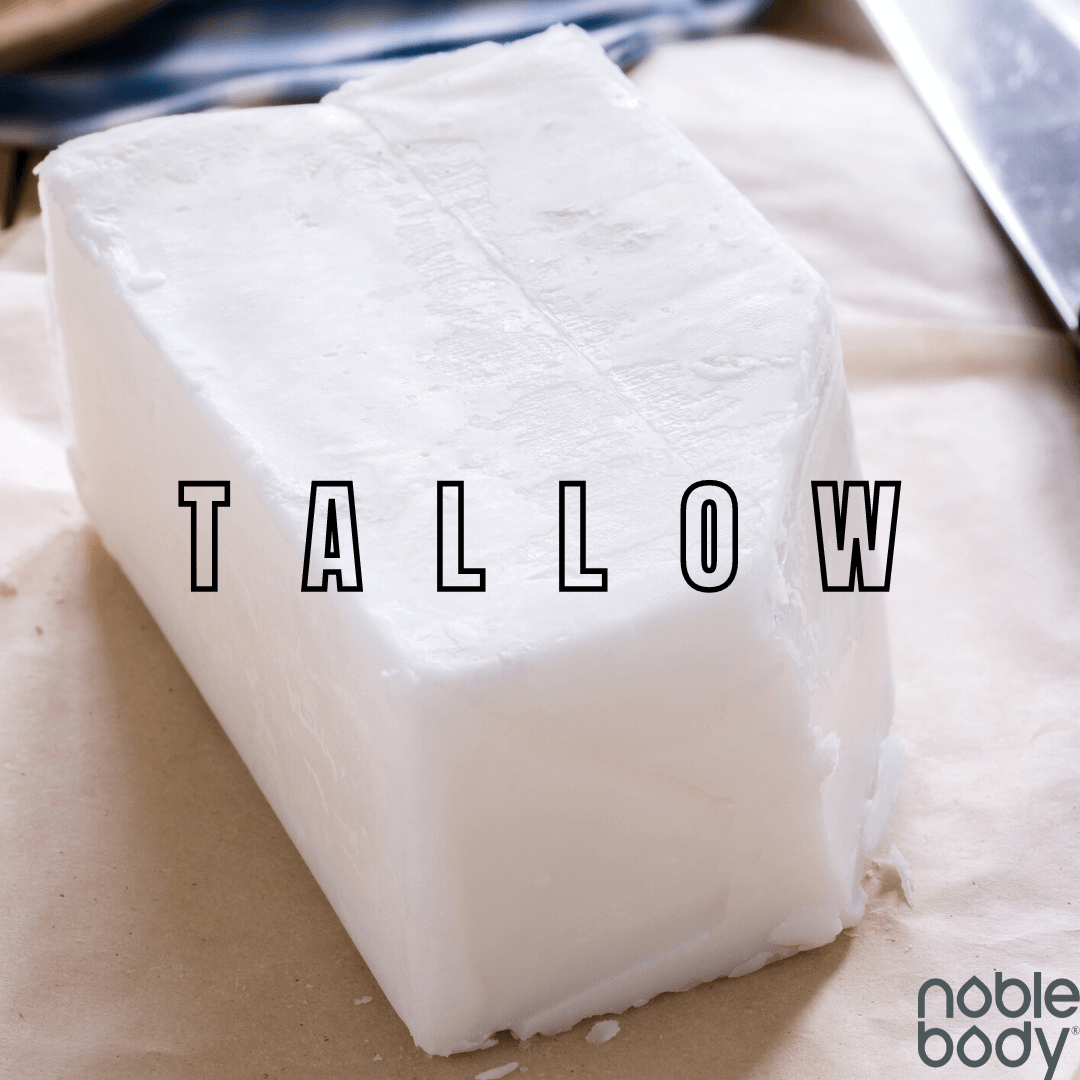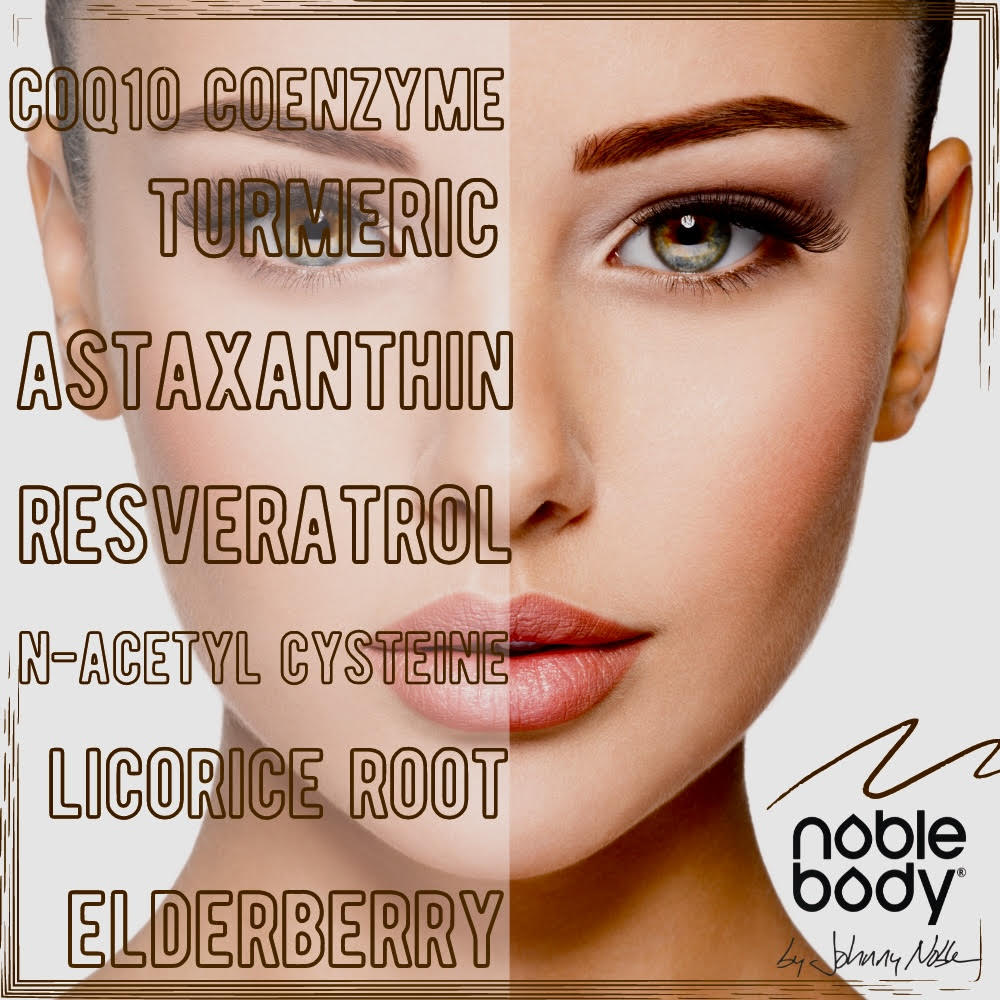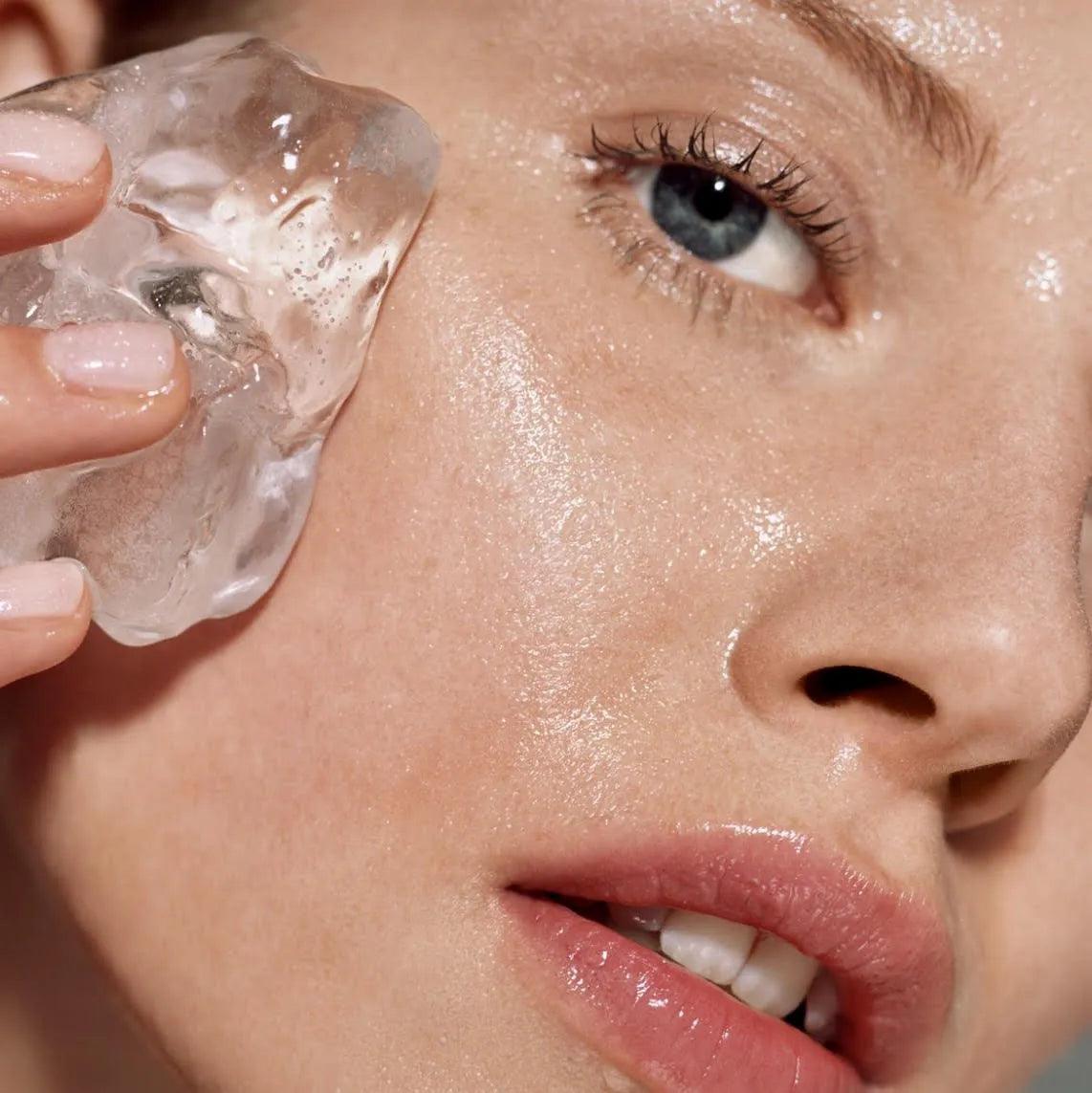Tallow for skin care is getting lots of hype lately, but is it warranted? Tallow is one of the hottest skin care ingredients on the social media scene right now.
Here are the answers to all your questions about using tallow on your skin and whether to jump on this cosmetic-ingredient bandwagon.
Tallow has been used for thousands of years because back in “olden times” people would not waste any part of an animal.
There are many ancient recipes passed down that include suet, tallow, and fats from cows, sheep, buffalo, and other domesticated animals. “Nose to tail” as the saying goes.
And of course animal fats have been used for many years in soap, lamps, candles, machine fuel, and lubricants.
Tallow has also re-emerged as a popular and natural cooking fat to combat the well-deserved hate highly-processed industrial “seed oils” have been getting lately.(Remember: Up until 1990, McDonald’s cooked its French fries in a mixture of 93% beef fat and 7% cottonseed oil.)
Tallow used in topical skin care is a more modern twist. So let’s dive in.
(*This article is detailed because I’ve been asked by Noble Body customers if I was formulating a tallow product and it's the result of considerable research.)
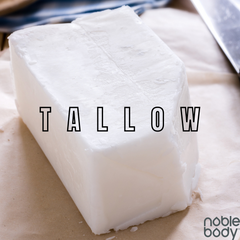
Summary of Conclusions ("TLDR")
- Like any product claiming to be “natural,” “organic,” “pasture raised,” or “grass-fed,” there are many factors that will impact the final quality and any beneficial effects it may have.
- Most commercial animal fat products are larger scale “factory farm” processed and refined fats from different animal scraps and carcasses, NOT actual suet/tallow.
- Unfortunately, and like the perpetual fake olive oil fraud, there's not enough actual tallow on the planet to fill the jars that are labeled as "beef tallow."
- The more the fat or tallow is refined, the less beneficial it is for skincare and for consumption.
- To have all of the supposed benefits for skincare, the tallow MUST be from an animal that was “pasture raised/grass-fed” and on a NATURAL DIET. They are what they eat is true just like for humans.
- The key with tallow skincare products is to KNOW EXACTLY WHAT YOU ARE BUYING. This can be a challenge but it is possible.
- The quality of the tallow for skincare is dependent on its nutrient and fatty acid composition which is entirely dictated by the animal’s diet and living conditions during its lifespan.
- Anything an animal is fed or exposed to will end up in its tallow or fat. This includes genetically modified feed (GMOs), antibiotics (and other drugs), hormones, grains, pollutants, heavy metals, and pesticides.
- Tallow companies with direct ties to clean/natural farming operations will have the highest-quality tallow for both skincare and consumption.
- Tallow does NOT have to be USDA Certified Organic to be of the best quality.
- Avoid beef fat (aka beef shortening, wrongly called tallow) that’s produced by large-scale factory farming operations and then highly refined with additives such as bleaching agents and preservatives. (For both skincare AND as food.)
- Many tallow/beef fat skincare products now on the market appear to be “private-labeled” formulas that companies buy in bulk and then re-sell in their own packaging.
What is Tallow?
Tallow is fat from certain ruminant animals (their natural diet is plants and grasses) and it’s strictly defined:
Tallow is “rendered SUET.” (Rendered means cooked and melted into a liquid fat, preferably at lower temperatures.)
So what is suet? Suet is an interior type of fat that surrounds the kidneys, heart, and part of the loins of the animal. In other words, Tallow/Suet is a SPECIFIC TYPE OF FAT FROM THE INNARDS OF THE COW.
Tallow IS NOT rendered scrap or carcass fat from other parts of the animal. That is just the animal’s body or muscle FAT. This is ordinary "beef fat."
There are three different types of fat in the animal’s body:
1. Subcutaneous, found directly beneath the skin.
2. Intramuscular (aka marbling) is the fat dispersed within the muscle tissues.
3. Visceral, located around the internal organs of the cow, mostly heart and kidneys. THIS IS THE COW'S SUET. WHEN RENDERED, IT BECOMES TALLOW.
Suet is rare: Every cow holds an average of 10 pounds of suet. (Lean: 10 lbs.; Average: 15 lbs.; 20 lbs for fat cattle. AND, Every pound of suet/tallow nets about only one gallon of liquid, finished tallow.
The highest quality of tallow comes from cattle. Suet from sheep (mutton) and buffalo is also made into tallow, but it’s not considered to be the highest quality.
The prized beef suet has a (mostly) whitish appearance and is slightly crumbly or even dry to the touch. It will have a slightly ‘meaty’ aroma. (The color and aroma will vary based on the animals’ diet, health, and similar factors).
Suet and beef fat will be in solid form at all but higher temperatures.
There is a fundamental disconnect on the VERY DEFINITION OF TALLOW by many producers, manufacturers/sellers of products, marketing literature, and by the end consumers.
The term TALLOW is being used interchangeably with ANY FAT that comes from the animal, not just the interior “rendered suet.” (MORE ON THIS DISTINCTION BELOW WITH EXAMPLES.)
Remember this: TRUE TALLOW IS ONLY FROM SUET AND IT BECOMES TALLOW WHEN IT’S RENDERED (melted.)
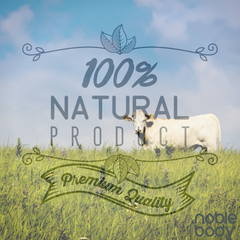
WHAT IS NOT TALLOW?
Many people believe that tallow can be produced from any rendered fat from any animals. Although people may use it, tallow is not the same as say, lard from pigs.
Thus, if a tallow producer or product seller says “grass fed beef tallow” then it should be ONLY RENDERED SUET from cows that were pasture raised and grass fed.
As detailed below, this is a critical distinction with the quality of the tallow, especially if you’re going to use it on your face.
For example, here’s a quote from Wikipedia:
“Commercial tallow commonly contains fat derived from other animals, such as lard from pigs, or even from plant sources.”
Note the misuse of the term “tallow” and also the questionable practice of adulteration. This seems more common with the larger “factory farms” as detailed below.
(In addition, these “plant sources” are most likely cheaper mass-produced oils like soybean or rapeseed, and which also likely GMO.)
Tallow’s Smoke and Melting Points
The melting point for beef suet/tallow is: between 112 °F and 122 °F
The smoke point for beef suet/tallow is ~400-430 °F
This is a consensus. It’s said to be even lower and higher according to some sources.
(NOTE: I consulted with a tallow company owner for both food and skincare and he says tallow's smoke point is closer to 350 °F. Every other source I saw says it's higher, but be forewarned and watch your temperatures because there is a divergence on this issue.)
(Beef fat from the rest of the animal that’s not suet will also be solid at room temperature, but it usually has a slightly lower melting point than the suet, about 110 °F to 115 °F.)
Smoke point is the temperature that the tallow would begin to burn and “oxidize.” This is quite a high smoke point which allows for high temperature cooking, searing, and frying without burning the tallow.
Burning and oxidizing natural oils creates harmful compounds (even carcinogenic ones) that are not healthy for human consumption especially over the long term.
(NOTE: There can be liquid tallow via the process of “fractionation,” where certain molecules are isolated, but this will remove certain fatty acids and reduce any beneficial effects of the tallow for skin care.)
Can Tallow be “ORGANIC”?
Does Tallow Have to be Organic? NO. Tallow can be, but does NOT have to be “USDA Certified Organic” to be high quality.
Tallow can be “all natural,” “grass fed,” and otherwise premium quality WITHOUT the cumbersome and expensive USDA Organic certification.
Many high quality farming operations surely forgo this expensive and cumbersome process. Without reprinting all of it, there is a detailed section in this Noble Body article about the USDA Organic certification process:
https://noble-body.com/blogs/news/are-100-natural-organic-claims-100-accurate
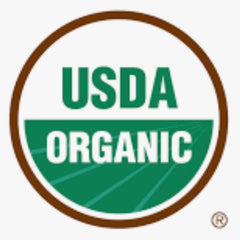
Here’s what one company says about organic tallow on their website:
“Our Tallow Balm is not certified organic. Organic standards aren't good enough for us or for you… all of our suppliers use the best methods in production, which include a 100% grass-fed and pasture-raised, non-toxic, chemical-free approach to farming with healthy soil and an overall healthy ecosystem without pesticides, pharmaceuticals, or any other chemicals. It is costly and time-consuming for a farm to be certified organic, so many excellent producers choose not to be, especially since the large ongoing expense of certification has to be passed on to the consumer…” [Bold added]
https://www.vintagetradition.com/tallow-balm-skin-care-frequently-asked-questions/#organic
(NOBLE BODY HAS NO AFFILIATIONS OR RELATIONSHIP WITH VINTAGE TRADITION)
WHAT’S IN TALLOW?
The ultimate chemical composition of the tallow is dependent on the animal’s diet, health, and living conditions.
Tallow is a blend of “fatty acids,” which are the building blocks of any natural oil whether it is beef tallow or coconut oil. Different fatty acids perform different functions and can have different benefits for our skin. (And our health if we are consuming it.)
Like many natural compounds, tallow can also contain beneficial vitamins and minerals for consumption, or for topical application.
There is a huge body of information about different types of natural fatty acids from plant and animal sources, but I’ll render it down (ha) and keep it simple.
Think about it like this:
The source botanical material (and processing or refining) will determine the fatty acid profile of any natural oil. Compare pomegranate seed oil to tallow. That visual helps you understand how one oil is so structurally different from another, but they can also share common fatty acids. Whether it’s a natural oil or an animal fat, the fatty acid molecules are still the same.
The fatty acid profiles of different oils means:
Different feel, texture, absorption rates, weight, pore clogging potential, natural aroma, shelf life stability, nutrients, benefits, and many other factors.
Think about how 100% coconut oil feels on your skin as compared to lighter, dryer, and fast absorbing oils like camellia or sweet almond. Or how pomegranate oil has a sweet, fruity smell vs a natural “meat” smell of tallow, or a nutty/earthy smell of golden jojoba oil.
The Fatty Acid Composition of Tallow
This is a key factor of any tallow’s quality and benefits for your skin and tallow’s composition can vary greatly.
Here’s two reputable sources on tallow’s fatty acid composition:
According to Wikipedia, the fatty acid content of tallow is:
Oleic acid 47%
Palmitic acid 26%
Stearic acid 14%
Myristic acid 3%
Palmitoleic acid 3%
(Capric, Lauric, Linoleic, Linolenic acids usually negligible)
https://en.wikipedia.org/wiki/Tallow
From a study:
“Beef tallow: Extraction, physicochemical property, fatty acid composition, antioxidant activity, and formulation of lotion bars.”
Oleic acid 38-45%
Palmitic acid 30%
Stearic acid 14-20%
Myristic acid 5%
Palmitoleic acid 3-5%
(Capric, Lauric, Linoleic, Linolenic acids negligible)
https://japsonline.com/admin/php/uploads/3447_pdf.pdf
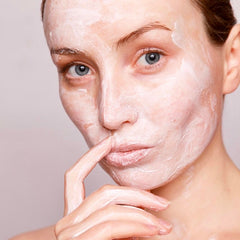
Is Tallow Similar to Human Sebum?
Many articles and sites claim (usually without any backup sources) that tallow is the same in composition to human sebum or that “tallow mimics sebum.”
Well, is this true?
No, not exactly. Not many compounds are similar to human sebum, whether they’re natural or not.
Sebum is our skin’s natural, oily lubricant and is secreted by sebaceous glands. It is a complex mixture of waxes and lipids.
Sebum functions to keep our skin hydrated and add an antimicrobial barrier to our skin microbiome as our immune system’s first line of defense against infection and pathogens.
(Probably the closest compounds to sebum in the natural oil realm are Jojoba oil (which is actually a liquid wax ester) and a similar oil, meadowfoam seed oil.)
The composition of sebum will vary, but here’s a reliable range of sebum’s lipids:
Glycerides* 30-50%
Fatty acids** 15-30%
Wax esters 25-30%
Squalene 10-20%
Cholesterol esters 3-6%
Cholesterol 1-3%
(*Glycerides form when glycerol combines with 1, 2, or 3 fatty acids. Their primary function is to serve as a kind of “fat storage molecule.”)
(**The glycerides (typically triglycerides) and the fatty acids are said to add up to about 55% of the total lipid content of sebum. This will vary, but it’s a reliable working range.) Source:
https://www.tandfonline.com/doi/pdf/10.1080/19381980.2017.1375636
The Fatty Acid Composition of Sebum
This study quantified the composition of sebum to form conclusions about acne.
https://www.ncbi.nlm.nih.gov/pmc/articles/PMC9253609/
Researchers found that sebum contains a total of 20 different fatty acids. The top 6 fatty acids (below) accounted for ~85% of the total.
palmitic acid (C16:0) 31%
sapienic acid (C16:1n-10) 21%*
stearic acid (C18:0) 11%
myristic acid (C14:0) 10%
oleic acid (C18:1) 8%
pentadecanoic acid (C15:0) 5%
*Note that the second most abundant fatty acid component in sebum is “Sapienic acid” which is unique to sebum and not found anywhere else in the human body. (It takes its scientific name from the root “sapiens,” as it is unique to humans.)
Sapienic acid is critical to the immunity functions of the skin microbiome. In the animal kingdom, it’s only found in human sebum.
So, the fatty acids common to both tallow and sebum are palmitic, stearic, myristic, and oleic acids.
Those fatty acids equal approximately 60% of the total of fatty acids in sebum and therefore up to approximately 1/3 of all lipid compounds in sebum. (Which can vary greatly depending on the tallow’s quality.)
So, tallow and sebum have several similar compounds, but certainly not enough to say that one mirrors the other or that “tallow mimics sebum,” which is a common claim with tallow.
Details on Tallow’s Predominant Fatty Acids:
Different fatty acids perform different functions and can have a diversity of benefits for our skin health and if it’s being consumed as food.
NOTE: The same fatty acids can be in many different natural compounds. Whether oleic acid is from tallow or camellia oil, it’s the same molecular compound.
OLEIC ACID: Is the most common fatty acid found in nature. It’s not considered an essential fatty acid, because our body produces it. Oils and butters high in oleic acid are moisturizing and regenerating for our skin. They are absorbed well into the skin and also offer softening, and anti-inflammatory properties. Other high oleic oils include: almond, camellia seed, and avocado oils.
PALMITIC ACID: Is the most common saturated fatty acid found in animals, plants, and microorganisms. It fatty acid forms an occlusive layer on our skin and helps protect it from environmental stressors. (Occlusive ingredients don’t just come from the cosmetics laboratories, there are many naturally-occurring occlusive natural oil compounds like Shea butter or Shea oil.)
STEARIC ACID: Is prevalent in nature and usually higher in animal fats. It offers great (even semi-occlusive) skin-moisture retention, an increase in flexibility, and even skin damage/injury healing and repair. A true champion for great skin health and regeneration. Great other sources include the “butters” like mango, cocoa, and shea.
MYRISTIC ACID: Is also occurs naturally in many natural oils and butters such as tucuma butter, murumuru butter, coconut oil, and palm seed oil. It’s also present in higher concentrations in bovine milk and breast milk. It has been isolated as an ingredient that functions as an emollient and texture enhancer with its velvety feel.
It’s compatible with water and oil, hence its use as surfactant in many personal care products. (Surfactants enhance that foamy/bubbly character of personal care products.)
PALMITOLEIC ACID: This amazing fatty acid is one of the building blocks of our skin to help prevent burns, wounds, and scratches. It’s also an active anti-microbial. Sea buckthorn and macadamia nut oils are also high in palmitoleic acid.
CONJUGATED LINOLEIC ACID “CLA”: Is an “essential fatty acid” and a type of omega-6 fatty acid. It’s a form of linoleic acid, a common omega-6 fatty acid found in foods and is now known to have many health benefits when it’s consumed.
BUT, to have the high and beneficial CLA levels, the animals MUST BE from pasture raised and grass fed tallow. (The industrial factory-farmed animals do not have high levels of beneficial CLA in their tallow.) Also, CLA is found in many other natural oils and compounds.
Other Tallow Vitamins/Nutrients
It is widely claimed that beef tallow can also contain high levels of vitamins A, D, E, K, and certain B vitamins.
“Tallow is rich in Vitamins A, D, E, K and B1.”
(I took this from an ad on IG and have seen many other claims like this.)
NO, it’s not.
I thought this was true until one of my expert consultants (and tallow/fat company owners) pointed out my error. He had this to say about these vitamin claims:
“Tallow, grass fed or not, doesn’t have the Vitamins purported (nor does Pastured Lard have Vitamin D for that matter.)
The “internet” simply asserts this.
Anytime I get push back on this I ask the pusher-backer to show me the lab results.
I always get crickets back.
We have done several tests and they’re not there.
We wish this were not the case as no one would benefit from this more than us.”
That says it all. I don’t know where the claim originated that tallow contains these vitamins, but it’s NOT TRUE.
If anyone does have lab test results that demonstrate this vitamin claim, let’s see them. support@noble-body.com
Tallow Shelf Life
There is some confusion on tallow’s shelf life. Some mistakenly believe it lasts forever, but it DOES NOT. Every natural oil has a shelf life and will go rancid. (Other sources mistakenly claim it’s much shorter than it is.)
Rancidity is because of oxidation. Oxidation occurs naturally and can be accelerated by exposure to light, air, and higher temperatures. Different lipids, like in tallow, or any other fat or oil, also oxidize at different rates.
Rancidity can be delayed with the addition of antioxidant compounds AND ANY QUALITY SKINCARE PRODUCT SHOULD CONTAIN THEM TO HELP STABILIZE THE TALLOW FROM OXIDATION.
(Natural forms of vitamin E and rosemary extract are commonly used natural compounds for this purpose and are effective to slow oxidation/rancidity and extend shelf life.)
AT ROOM TEMPERATURE: Tallow can last six months to a year depending on the conditions. There’s no reason to keep it out this long if you are not using it quickly. It’s oxidizing every moment.
(When going rancid, tallow will have an “off” smell and taste, certainly not pleasant. “Fishy or sour” it has been called. You’ll know it when you smell it.)
REFRIGERATED: Tallow can remain fresh for about a year, maybe even a bit more.
FREEZER: Tallow can stay fresh at least two years, but watch for freezer burn and make sure it’s tightly sealed to avoid unwanted odors.
(Note that the type of heat processing can also shorten tallow’s ultimate shelf life.)
How Tallow functions on our skin
Cosmetic ingredients are placed in only a few categories based on what they do to and for our skin. Those categories are: Emollient, Occlusive, Humectant, and Active Ingredients.
Tallow is usually thicker and heavier and it has both emollient (hydrating/moisturizing qualities) and Occlusive properties (it leaves a thin film behind and has the effect of blocking things out from the skin, or holding things in such as moisture.)
Pure tallow mostly acts as a moisturizing emollient on the skin adding hydrating and softening properties and any nutrients it possesses. Remember, skin needs nutrients too.
The tallow absorption rate is slower because it is comprised of heavier lipids. This can obviously be managed by the amount you put on your skin at one time so it has the opportunity to absorb.
(Note that absorption can be impeded by the use of other products that contain occlusive ingredients prior to the application of tallow.)
Tallow Comedogenic rating
A common misconception is if a fat or oil is heavier or thicker it will clog pores. This is not correct. It’s determined by the oil’s comedogenic rating. “C-Rating”
The C-Rating is a system to determine if a particular product or compound will clog your pores, especially if using it on your face.
The C-rating for PURE TALLOW is 0-1 meaning it is NOT likely to clog your pores.
(BUT, everyone’s skin will respond differently to compounds. What may clog one person’s pores will work fantastic for another.
ALSO note that many commercial tallow skincare products contain other ingredients such as olive oil, honey, beeswax, etc. that will change and may raise the C-Rating, so watch the ingredient lists.)

How tallow is processed
As you will see, there are two main methods that tallow and beef fat are processed for food and skincare:
1. The good ways
2. The “factory farm” commercial ways with very little in between.
A critical quality issue with beef tallow after how it’s raised is how it’s processed.
In this case, the smaller scale and true “grass fed, pasture raised” tallow suppliers for skincare are VASTLY SUPERIOR to the larger factory farm operations. The difference in the quality of the tallow and processing is like night and day.
The good way is by smaller farms that adhere to the pasture raised, grass fed, and no chemical approach.
The bad way is done by the large factory farms with cheap grains, GMO feeds, drugs, exposure to chemicals and pesticides, and everything you DON’T want in or on your body.
First, the Bad Way Tallow is Processed
Larger scale producers of bulk beef fat (NOT SUET) are quite literally the “glue factories” we joke about.
And there’s nothing wrong with this. There are MANY commercial uses for animal fats from foods to manufacturing, just not for use on your face in your skincare routine.
Here’s how it’s typically done:
Large amounts of “offal” (from slaughterhouses) is processed to extract the animal fat. It's usually a mix of cows, pigs, and chickens because the big companies process all of them.
The most economical way is “wet rendering” where all of the animal parts are crushed and cooked in H2O at about 200 degrees Fahrenheit to extract the fat. (There is also a “dry” rendering process but it’s rarely used because it’s costly and impractical.)
Then the rendered fat is bleached, neutralized, and deodorized into refined beef fat (also called beef shortening in the food industry) and depending on the usage, BHT, BHA, and/or propyl gallate are added as preservatives.
(Remember, tallow does go rancid, and this can accelerate, especially if it’s been cooked.) Cooking will also impact the final nutrient/beneficial contents of tallow.
Here’s that process detailed by a large-scale beef fat supplier. (Note the incorrect use of the term “tallow.”)
https://products.whc-oils.com/item/all-categories/edible-beef-fat-oils/edible-beef-fat-oils
"Edible Beef Fat is obtained by heat rendering of tissues (cuttings and trimmings) from beef, which is then refined, bleached and deodorized."
https://products.whc-oils.com/Asset/tbeeffat.pdf
Here’s one for “50 lbs of grass fed, food grade, beef tallow in poly bag in box.”
“Culinary uses as well as an ingredient in soap making and skin care products.”
“A creamy unbleached beef tallow rendered from only pure beef fat … from all fats of the bovine.”
And they add the following so you can see the distinction between ordinary beef fat and tallow fat:
“If you require a product that is solid at room temperature then you should order the more expensive tallow rendered only from the kidney fat of the cattle.”
As you can see, it’s not tallow, but beef fat that’s probably been wet rendered by someone somewhere. If you’re going to use tallow on your face, this is not what you want.
https://www.essentialdepot.com/product/TALLOW-50LB-BOX.html
Here’s another example if you want a metric ton of “100% Pure Beef Tallow Fat - Edible and Inedible Beef Tallow” for 700 bucks. (Note again the misuse of the term “tallow.”) I can guarantee you it’s not true tallow and you don’t want to rub it on your face or body.
https://www.ec21.com/product-details/Where-To-Purchase-Quality-Beef--11656655.html
Next, the Good Way Tallow is Processed
The quality of tallow products on the market can vary wildly. The key quality question is “how do you know what you’re buying?”
Smaller scale producers—and they do exist—will take more time and effort on the final product and its quality.
Here’s a good example, again from Vintage Tradition. From the text below, they understand where the actual tallow comes from, the different types of processing for tallow and animal fats, and they have direct relationships with ranches that employ the pasture raised and grass fed animals:
“We render all of the tallow ourselves from beef suet (interior fat), and not scrap fat, using our own special process, with the lowest heat possible and no water (i.e., not the "wet" method), ensuring that the tallow will not undergo oxidation or rancidity. Even from the suet we do receive, we are very selective about what material actually goes into the rendering."
"We don't obtain tallow rendered by others because we want it done our own special way as described for the sake of quality, stability, and maximum therapeutic benefit to the skin. We cannot know or rely on how others might produce their tallow, and we want full control over the process and the quality.”… [Bold added]
https://www.vintagetradition.com/tallow-balm-skin-care-frequently-asked-questions/
(NOBLE BODY HAS NO AFFILIATIONS OR RELATIONSHIP WITH VINTAGE TRADITION)
Here’s a good example for tallow (and many other animal fats) in skincare and as food:
“Fatworks' Grass Fed Beef Tallow in bulk is made from Pasture Raised, 100% Grass-Fed & Finished Organic suet. Fatworks' Grass Fed Beef Tallow in bulk is made from Pasture Raised, 100% Grass-Fed & Finished cows.” … (Note also that they completed the USDA organic certification process.)
“Skincare makers note: There are seasonal and batch differences that will make for varying consistencies. We have had batches in which the tallow is hard and sometimes where it is softer. We do not homogenize, bleach, or deodorize. Our tallow makes great skincare but please be aware that it may vary from batch to batch based on what nature gives us.”
https://fatworks.com/collections/buckets-o-lard/products/organic-beef-tallow-1-gallon
(NOBLE BODY HAS NO AFFILIATIONS OR RELATIONSHIP WITH FATWORKS)
A FINAL NOTE ON “WET” VS “DRY” RENDERING: It’s important to understand the different methods of rendering tallow and beef fat to assess what is good/healthy and what is not. Especially when we are talking about tallow/fat uses for skincare.
For instance, there is a gentle and natural wet method of rendering tallow with water and salt. After long, low, slow heating, the fat and water separate and the fat can be extracted. (Usually after cooling overnight so the fats solidify.)
There is also the industrial high-pressure steam and centrifuge wet method which is not natural or gentle. So, wet rendering can also be “good,” it just depends on the actual method employed.
And, there is also an industrial high temperature centrifuge dry rending process that’s not so natural and gentle. It’s also not used much anymore because it’s impractical.
So to summarize, don’t get the impression that dry-rendering equals good and wet-rendering is bad when in fact they can both be good or bad depending on the process used to render the fats.
The consistency and quality of the Tallow
As you can see, sourcing and quality are a critical issue with tallow skin care products.
The question with quality is really how do you know what you’re buying? And this seems to be the biggest question surrounding tallow products on the market for skincare.
It also seems that there are many private-labeled tallow products on the market now. The homogenized appearance and similarity in many ingredient lists is too close to ignore. This is not surprising and will happen whenever a type of ingredient gets hot or takes off in our modern internet times.
After researching many different tallow products on the market, I concluded it’s highly unlikely that all of them are truly suet/tallow from “grass-fed and pasture raised” animals. In many cases, it’s most likely refined and chemical adulterated animal fats, especially if it’s pure white and without the natural animal aroma.

Are there Downsides to using Tallow?
The popularity of REAL SUET/TALLOW for skincare is a testament to its benefits. It’s hard to open any social media app now and not see a tallow for skincare ad.
Many people are now using it and swear by it for their skin. So what are some of the negatives of using tallow for skincare? Here are some factors I’ve gleaned from blog articles, comments, reviews, and my own research and testing:
Tallow’s thickness and texture
Tallow tends to have a heavier/greasier texture, so not using too much so it can fully absorb is the key. Tallow SHOULD come in a solid form because of its melting point, so it takes a bit of working in the hands so it can be applied. (As noted, there are sometimes liquid “fractionated” versions of tallow products as well.)
Under some conditions, tallow can have a gritty or grainy texture. (I believe this crystallization usually occurs when the tallow melts and then re-solidifies.)
Tallow is not cruelty free
Obviously, the animals have to die to extract the tallow, so it’s not a vegan, vegetarian, or cruelty free option.

The smell of true Tallow
This seems to be a big factor with many people. If you are using real tallow, it’s going to have a natural “meat” smell.
From a Twitter/X user:
"I wanted to make a tallow product but could now for the life of me get the farm animal smell out. I smelled so strong my dog would follow me around drooling."
If it does not have some remaining natural smell, it’s probably heavily refined or homogenized which has also removed many of its natural benefits. (I saw several tallow balm companies stress that there is "no tallow smell" in their product descriptions.)
(Some companies mask this natural smell with fragrance ingredients like essential or fragrance oils, so it’s up to the consumer to decide if that overcomes any smell issue.)
Tallow purity, sourcing, and processing concerns
As noted above, a big issue with tallow products is how do you know what you are getting? Real suet/tallow is quite rare as noted above.
A lot has to happen for the tallow to get in a small cosmetic container from the life of the animal, its diet, and through the entire processing chain.
As you have seen, there are many factors along the way that will impact the final purity and quality of the tallow. If you're not using true suet/tallow and some refined and processed beef fat, it defeats the whole purpose of using it in your skincare routine.
(FYI, the FDA issued a statement in 2017 about “mad cow disease” and beef/tallow products in cosmetics but I don’t think it’s anything worthy of concern or discussion.)
Is Tallow better than other skincare products?
This is the eternal question in the cosmetics arena. My answer is always the same: If you find something that works for you and gives you the results that you desire, then that’s what you should use. Simple, yet complicated since we are bombarded with choices about what works or what’s the “best" for our skin.

Conclusion
I hope you found this article useful and informative. It was helpful to me to learn (a LOT) more about this latest skincare trend and it also made me conclude that I will not be doing a tallow product at this time.
The main reason is the quality and sourcing concerns of the raw tallow. I don’t yet have a raw suet/tallow source that I’m comfortable with and I would not formulate a tallow product unless I knew exactly what I was using as the base material.
AND, I don’t see that I can create more effective formulas using tallow than I already have with these Noble Body face and body oil formulas.
https://noble-body.com/products/face-oil-for-men
https://noble-body.com/products/face-oil-for-women
https://noble-body.com/products/noble-body-fit-body-oil
************************************************************
Regards and many thanks for reading.
My prime directive with Noble Body is to produce healthy and natural skin and hair care products using only the finest ingredients that I select.
I will not deviate from this promise and I'm not nearly done yet...
Peace, great skin, and Love to everyone.
Johnny Noble, February 2024
noble-body.com
support@noble-body.com
©Noble Body LLC 2024
